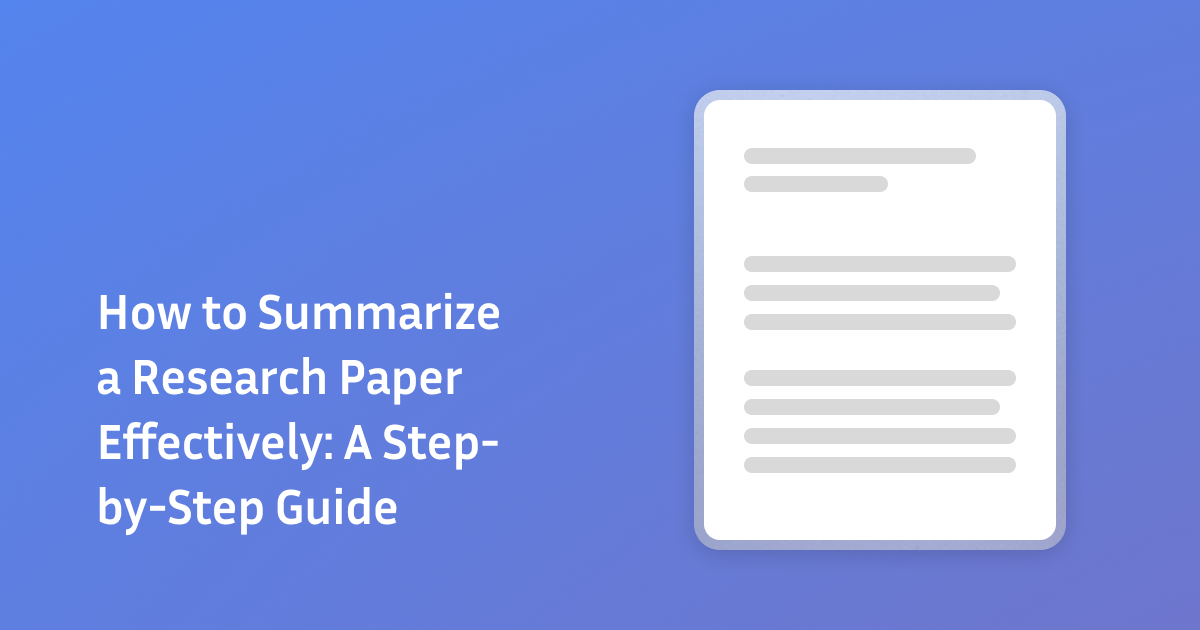How to Summarize a Research Paper Effectively: A Step-by-Step Guide

It is a non-negotiable skill for an academician or researcher to be able to summarize their paper. The art of presenting complex ideas into readable insights is a need for students, academics, and anyone who is involved with research.
A research paper summary helps you extract the critical points that will scientifically back your paper and convey key insights. In this blog, we will discuss the process of summarizing research papers, highlight common pitfalls to avoid, and guide you in your paper summarization journey.
The research summary is not only about making facts accessible, but is also the foundation for further studies. It is a time-saving process that facilitates knowledge retention and effective communication, which tends to get lost in lengthy facts and figures.
What Is a Research Paper Summary?
A research paper summary is a crisp version of the entire work or paper to help you understand its purpose. The need for writing research summaries goes beyond mere understanding. It is the foundation on which you lay your new work. Not only that, it lets you capture the key findings, methods, and conclusions without reading the entire paper.
The need for a summarizer has always existed, and luckily, we now have the means to address this need through AI.
Steps To Summarize A Research Paper
Regardless of whether you are summarizing for a paper or a presentation, the steps remain the same. You gain an insight into the paper to understand its intent and omit the irrelevant points. That’s it!
- Read the Paper Thoroughly: For you to understand what is critical and relevant to the topic, you have to undergo the tedious task of reading the paper. The discussions, the conclusion, and the facts and figures stated in it are what will help you summarize it.
- Highlight Key Points and Arguments: This is the most critical step in your summarization process. You have to keep highlighting the main arguments while reading to ensure you incorporate them in your summary.
- Identify the Main Thesis and Conclusions: Identifying the main arguments is not enough. You also need to understand the paper's theme to know what it’s about and how it reaches its conclusion. Only then can you summarize it accurately without losing the essence.
- Write the Summary in Your Own Words: Writing it in your own words is the ultimate challenge. How well you have retained the knowledge is directly tested by your capability to write the summary. If you can't accurately summarize the content, you won't highlight the content’s intent. Present your findings in a clear, logical order, and you are all set.
- Revise and Edit for Clarity and Conciseness: Do not forget to look back at your work and make the necessary edits. See if you can shorten the summary further without losing out on the work’s intent.
Always take time to review your work and make necessary edits. Focus on trimming unnecessary words while preserving the core message. To simplify this process, you can use an AI-powered tool to summarize any research paper content without losing its essence.
Research Summarization Using AI Tools
You will be relieved to know that you can also use AI tools to summarize the research papers. Tools like Paperguide AI make the entire process easier and take away the pressure of all these mundane and tough tasks from you. You will be able to appreciate its proficiency a bit more as you take a quick sneak peek into its workflow.
If the manual steps to summarize research papers feel overwhelming, you can use AI tools to save you the hassle. These tools use advanced AI algorithms and Natural Language Programming to analyze the data and understand the context of the paper. Based on this, you can use them to summarize your paper and provide you with answers to specific questions.
One such example of an AI tool is Paperguide AI. Its AI Research Assistant has Research Paper Summarization features to ensure that you don’t have to go through every page of the paper. Even then, it ensures that you don’t miss the paper’s nitty-gritty details.
It delivers fast, accurate, and efficient summaries, saving you time while ensuring precision. A quick look into Paperguide’s features as a Research Paper Summarizer will help you understand why it is the best option to rely on.
As an example, we used Paperguide’s AI Search feature to look up the topic “The Impact of Social Media on Mental Health”. Paperguide’s advanced AI algorithm fetches and analyzes the top 10 papers to deliver you an insightful summary, replete with sources for all the points.
However, Paperguide also allows you to summarize specific papers through its Chat with PDF feature. All you need to do is upload your paper and click “Proceed”.
The AI will then analyze the paper’s contents and provide a “Summary” option.
The Summary option provides you with detailed insights based on the paper’s contents, which you can use for your research.
You’ll also get options to check out the paper’s Methodology, Limitations, Key Findings, Abstract, etc. Apart from that, you can mention the paper and ask questions relevant to your research.
Common Mistakes To Avoid
Summarizing an article is more than just shortening it; there is more to what meets the eye. You have to be very mindful of the points you discard and the ones you keep.
- You must not overload your summary with several intricate details that are tangential to the main theme. The inclusion of too much information makes it another complicated piece in need of another summary.
- The way you perceive the summary holds the possibility of changing its meaning entirely. So, it would be in your best interest to not assume and write, but support your points with the logic presented in the paper.
- Refrain from quoting vague details that do not contribute much towards simplifying the objective of the paper.
- It is advisable to paraphrase rather than quote directly from the paper to ensure contextual relevance.
- Lastly, make sure that you follow a certain structure while telling your story. This will help the reader connect the dots.
Tips For Effective Summarization
At the end of the day, summarization is just the shortening of an already existing work that has been fact-checked. So, it takes away the burden of research for you. All you have to do is make sure you are purposeful and incorporate all the facts and figures in your abridged version. Effective summarization strategies are just a few quick things that you have to keep in mind.
- You can work around this task by making sure you are writing down all the points that are critical to the paper.
- The purpose of the summary is also to get rid of ornamental language to ensure you get your point out clearly. So, make sure that you stress clarity in your writing.
- It is wise to remember that a summary is about objectivity. Don’t add extra opinions in the summary, unless it is explicitly required.
- Lastly, always intend to figure out the core message of the paper so that your summarization is on point.
Example Of A Research Paper Summary
If you are still in need of some fine-tuning of your summary skills, you can consider the below example.
Consider this paper: The Impact of Social Media Use on Academic Performance among University Students: A Pilot. It talks about understanding the implications of social media on the academics of students. The paper is a study done on 300 students and discusses the findings in detail.
When you sit down to summarize this paper, you have to get rid of all the unconscious bias you have for social media. You have to remember that your opinion is not necessary here, but the idea is to highlight the findings of the study.
You have to educate your readers on how the author of the research implemented the study, and the circumstances surrounding it. Directly jumping to the conclusion that social media is harmful is not a viable choice. It neither upholds the integrity of the paper nor the authenticity of your summary.
Here’s a 200-word summary of the paper that we’ve taken as an example:
Make your readers understand what it took for the author to arrive at the conclusion, while reducing the word count and maintaining clarity. An accurate summary of scientifically conducted research like this has to include all the key circumstances for it to stand apart.
Conclusion
Summarizing a paper is not a difficult task. Follow the steps mentioned here, practice, and you’ll get the hang of it soon. The idea is to make complex facts and figures digestible, without losing the paper’s authenticity and intent.
Plus, as a writer, you have to restrict your creativity to a certain extent to ensure you do not overload your readers with too much information.
Frequently Asked Questions
1. How do I identify the main points in a research paper?
The main argument of the research paper usually contains the critical points. You can even browse through the conclusions, the drawn hypothesis, and its results to understand what the paper talks about.
2. How long should a summary of a research paper be?
A 20-page research paper should be summarized in a maximum of two pages. The concept is to stick to 10 to 15% of the paper’s total length.
3. Are there specific techniques for summarizing complex papers?
There is no specified way to break down a complex paper. You have to follow the logical steps of understanding the main argument and compartmentalize the paper as per the sections.
4. How do I ensure my summary is accurate?
You will get to know your summary is accurate once the theme of the paper matches with your summary. As in, if your summary and the paper in hand talk about the same theme and conclude the same way, you’ll know that you’ve succeeded.
5. What are common pitfalls to avoid when summarizing?
The biggest pitfall that you have to avoid while summarizing is to misinterpret the facts presented in the paper. Moreover, adding irrelevant details just to showcase your creativity can also deter your cause.
6. How can I improve my summarization skills over time?
Summarization can be perfected with time and practice, without a doubt. All you have to do is implement the feedback that you receive and take the constructive criticism in your stride.





